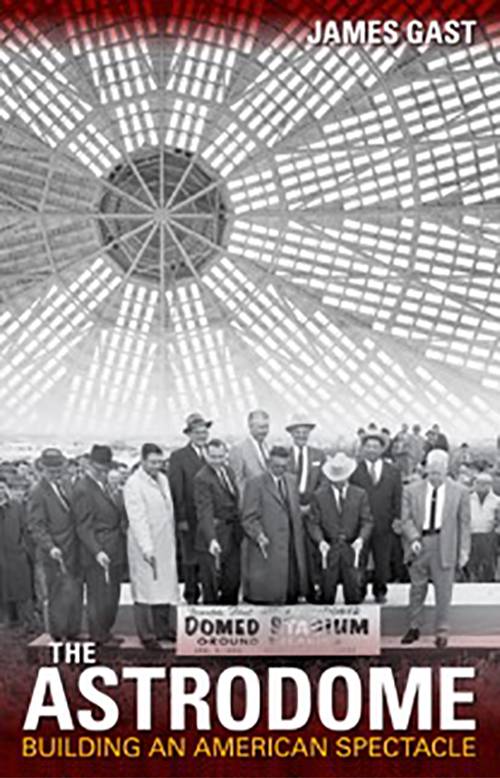"The Judge" and the Dome

The Astrodome: Building an American Spectacle
by James Gast
Boston: Aspinwall Press, 2014
200pp. $ 14.85 paper
Reviewed by
James Wright
The Astrodome has been reduced to a problem. For the ever-forward-looking city it calls home, the Dome, as it is known in Houston vernacular, poses a problem of paradoxical proportions: should the structure stay or go? As a one-time herald of architectural possibility, its function is entirely anachronistic, say the Dome’s detractors, and thus anathema to Houston’s unrelenting vision of progress, its unabashed promotion of the future over the past. As a monument of American architectural history, the Dome, say its supporters, merits preservation and stewardship, acts that would simultaneously save the Dome and begin to reorient Houston away from its notoriously myopic planning practices. As the debate continues over the Dome’s place in the story of Houston, it will celebrate its fiftieth anniversary in a state of dormancy.
Proposals for the Dome’s future range from turning it into the world’s largest indoor water park to refashioning it into a giant parking garage to ending its future altogether—the Houston Livestock Show and Rodeo and the Houston Texans, on whose ground the Dome sits in the shadow of the Texans’ NRG Stadium, are in favor of razing the Dome. After Harris County voters in November of 2013 rejected a $217 million bond plan to remake the Dome into a convention center, its fate is now in the hands of County Judge Ed Emmett and the Harris County Commissioners Court. Emmett, for his part, is on record as being in favor of saving the Dome, a stance that would align him with his most legendary predecessor, Judge Roy Hofheinz, the outsized public figure who, through his political acumen and unbending resolve, is responsible for conjuring the Astrodome into existence.
It is Roy Hofheinz who is at the center of James Gast’s The Astrodome: Building an American Spectacle. Although the initial legwork to bring major league baseball to Houston was put in by figures such as George Kirksey and Craig Cullinan, it was Roy Hofheinz, known publically as “the Judge” for the nearly ten years he spent as Harris County judge who piloted the franchise through its challenging inception. Hofheinz, as Gast gamely demonstrates, is largely credited with the features and practices that shaped the first few decades of the Astros franchise. Hofheinz conceived and oversaw the construction of baseball’s first indoor and “only air-cooled stadium”; established the stadium’s innovative and oft-imitated 474-foot electronic scoreboard; introduced themed restaurants to match the space-age theatricality of the rest of the ballpark experience, which included stadium staff “clad in astronaut suits.” During its construction, Hofheinz also altered the original design plans of the Dome to convert the top deck of the stadium, a space occupied by “massive sheet-metal ducts,” to what have now become mainstays of every sports stadium—luxury suites.
Despite Hofheinz’s pioneering vision, the first-of-its-kind stadium was not without its early problems. After it quickly became apparent that the 4,596 skylights that comprised the “great domed roof” made tracking fly balls nearly impossible (players took to “wear[ing] their batting helmets in the field” during the inaugural workouts), two coats of glare-reducing paint had to be applied. With the ceiling-glare problem solved, another gradually emerged: dead grass. Without sufficient sunlight, the Dome’s grass playing field, which Gast carefully documents as having never shown much promise from the beginning as a viable long-term playing surface, began to wither and had to be “repainted regularly.” The revolutionary solution to this problem, of course, would lead to the implementation of that most ubiquitous of sports playing surfaces whose prevalence continues to this day: artificial turf, or more specifically—AstroTurf.
With its major design flaws mostly behind it (the famed AstroTurf would not be installed until the following season), the Dome could finally fulfill its raison d’être: baseball. On April 9, 1965, the Astros hosted their first game in the Dome, an exhibition against the New York Yankees. While Mickey Mantle earned the first hit and the first home run, the hometown Astros won the game 2-1. Although the Astros would go on to a losing season, a trend that would continue for the next three seasons, the Dome, as Gast skillfully illustrates, in the span of three short years had gone from a giant hole in the ground to a “showplace stadium,” as Hofheinz characterized it, that “changed the game of baseball,” verily sports entirely, in how it is played, viewed, and experienced.
The Astrodome is most assuredly a revealing and efficiently delivered account of the human energy and political machinations behind one of the twentieth century’s most captivating structures. Constructed a mile from the Pierce Junction oil field, the site of “the first big [oil] strike in the Houston area,” during a time when “limitless optimism” was transforming Houston into the headquarters of “the manned space program,” the Astrodome is a quintessentially Houston structure built by quintessentially Houston figures. A work of unprecedented engineering, the Astrodome, as Gast, a registered architect and one-time Houstonian, admirably tells the story, “came to be because a group of Americans decided it should, and then just went ahead and did it.”
James Wright is Houston regional editor for Texas Books in Review. He teaches composition and literature at Houston Community College, Southwest.
